By Michael Chotiner

Traditional Scandinavian sod roof home.
The crowd I hang with these days — professionally speaking — consists mostly of small builders and remodelers. To find inspiration for home improvement articles, I often prowl online professional forums like contractortalk.com, forums.jlconline and roofingtalk.com to see what the pros are saying to each other about their work. The topics most often involve structural problems and power tools rather than innovative gardening techniques. But increasingly, there’s buzz about green roofs from remodeling contractors who may have never before considered installing one. Small residential contractors are getting a chance to bid on them, and in the absence of much experience, they’re asking their peers for advice.
Here’s a typical thread-starter from the jlconline forums, by a West Virginia contractor:
Green Roofs in Cold Climates?
Looking at a set of preliminary plans that include a roof that is to be an “extensive green roof.” Roof size to be 20′ x 44′. There will be an access stair and door to roof. The entire roof will be surrounded by solid 3′ tall sided walls with 4 scuppers to drain. Plans call for:“TYP. ROOF CONST: 14″ TJI @ 16” OC W/
3/4″ PLYWD, RIGID INSUL. SLOPED TO DRAIN,
HEAVY-DUTY EPDM OR TPO MEMBRANE,
CLOSED-CELL SPRAY FOAM INSUL. BETW.
JOISTS, & 1/2″ GWB CLG.”The area in which it will be built averages 60+ inches of precip annually including 150″ – 250″ inches of snow.
My first thoughts: Hot or unvented roof assemblies are problem prone in this area. Recessed lights cannot be spray foamed in and even if they were it would be impossible to get min. R 40 above them.
I know it would look really cool, and I don’t want to say it to loud, but this does not seem like a good idea to me and likely to be nothing but problematic with the snow and freeze thaw cycles we get around here. So am I being a spoil- sport here? Any thoughts appreciated.
The post elicited many responses — most of them constructive. One colleague from Toronto posted a sample of a green roof that had been completed in his area, noting that it, too, was subject to extreme cold and frequent freeze-thaw cycles. But he also posted this cautionary note:
“Estimated membrane life of 35 years. Anybody care to calculate the cost of removing 6 inches of soil etc. in case of a failure before then?”
There were also questions and comments about the spec for the I-joists (too small and far apart for the likely load), provisions for installation of the lights, ductwork and insulation. The best technical advice came from a knowledgeable Portland, Oregon, architect who was able to suggest specifics for installing tapered insulation, protective sheathing, two waterproofing membranes and a drainage mat above the primary roof deck and beneath the planting medium.
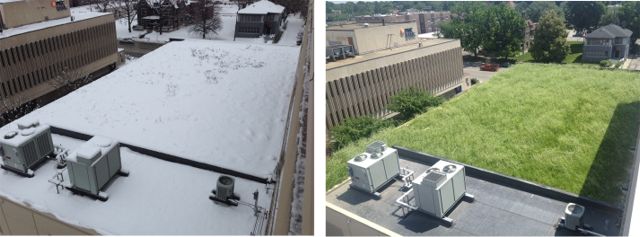
WFYI Indianapolis (IN) offices in winter and spring using a single source modular system from Omni Ecosystems.
Professional Roofer’s Question About Green Roof Prep
I also saw this post on roofingtalk.com:
“We’re doing a TPO roof that will have a green roof on top of it (by someone else). What can we expect when we’re finished and out of there? What precautions should be taken with regard to the warranty, etc.?”
A Chicago roofer replied with questions of his own:
“First off, was the roof designed to be a garden roof? I mean is it 45-mil TPO? Is it mechanically attached? Was the insulation mechanically attached? These would be no-nos.”
The response went on to advise that when the contractor finishes the TPO application, he should perform a “flood test” — block the drains and flood the roof — literally, try to make it leak. This way, he can spot and fix any problems before the roof is covered. He also advised applying a separation layer between the roof and planting medium once he was sure that the waterproofing layer was sound. Finally, he suggested that the contractor contact the roofing manufacturer to find out what warranty limitations might apply to roofing covered by a garden.
Another respondent, a forensic engineer based in Colorado, advised the roofing contractor to have one of his own workers on site throughout the garden installation to make sure that the roofing wasn’t damaged in the process, and to make repairs immediately if it was.

Various stages of the custom built-in-place design at The Ohio State University Green Roof at Howlett Hall in Columbus by Higher Ground Green Roofs, Roofmeadow, rooflite®, Moerings USA / Sempergreen and more.
Reaching the Small Contractor Market
What I’m seeing in the forums tells me that there is growing demand in the small-contractor markets for green roofs, and a need for technical and how-to information that enables residential contractors to take on green roof construction with confidence.
Yes, a number of good courses are available, online and elsewhere, as well as books for small green roof construction. Providers of green roof systems and components make a lot of good information available in less formal formats, including pamphlets, brochures and other collateral marketing materials.
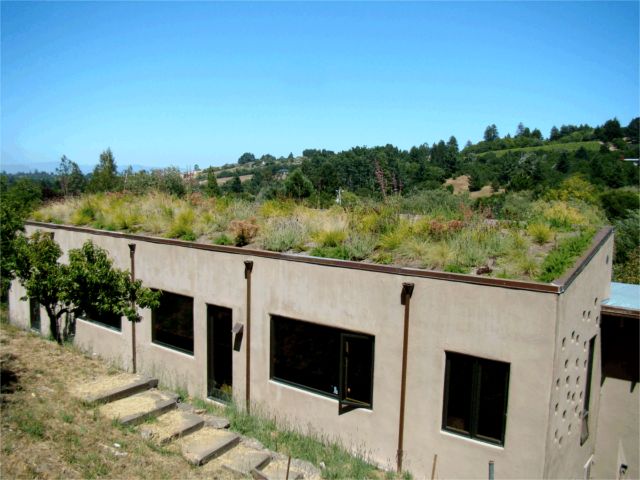
Wind Dancer has a custom built-in-place greenroof on a single family home in Sonoma County, CA from the design/build firm of SYMBIOS ecotecture.
But for the small contractors in my crowd, each job has a life of its own. Most remodelers are familiar with structural and waterproofing standards for the sloped roofs that are typical on most homes around the U.S. Most residential contractors are comfortable re-roofing with asphalt shingles and metals. They all have the circular saws they need to cut roof framing when it needs to be repaired or reinforced, drill/drivers and impact wrenches for sistering joist and rafters, and pneumatic nailers for getting shingles down in a hurry.
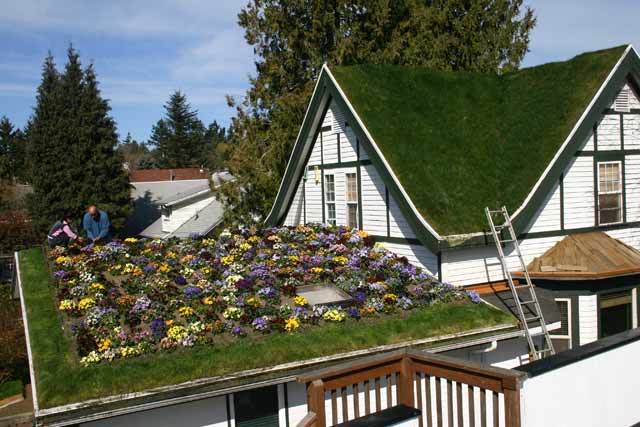
A built-in-place custom designed vegetated roof, Troy’s Green Roof is located in Tacoma, WA. Troy Wagner, the homeowner, is a roofing contractor.
But few have ever worked with built-in-place systems, lightweight modular planting panels or modules, and retaining systems (now available for green roofs in sloped applications), and most contractors don’t often work with the waterproofing membranes and root barriers that must be installed beneath a green roof. And, if the system is built-in-place, it will also require drainage materials. The engineered soil, or growing medium, should be site specific along with the appropriate plant selection.
While remodelers are often familiar with options for waterproofing flat and low-slope roofs — the kind that lend themselves to intensive green roof installations — they’re more likely to sub out the work to commercial roofing specialists, often because it doesn’t make sense for them to acquire the training and equipment necessary for jobs that they might do only occasionally. Not many remodelers have heat welders required for sealing the plastic waterproofing membranes used beneath some green roofs. I wonder how many commercial roofers bid green roofs without fear, unless they have received specialized training!
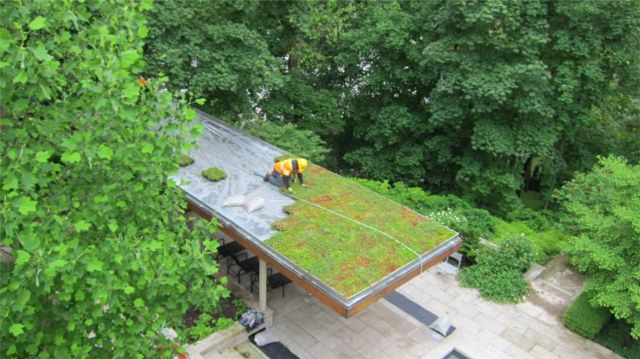
The Daniels Residence in Toronto uses a modular system from Vegetal i.D., a single source green roof provider.
To make good bids and reduce their risk, residential builders and contractors need the help of professional engineers to evaluate the load-bearing capacity of the roof frame and the loads that the finished project will be subject to. They need warrantable materials and designs for insulation and waterproofing layers, bulletproof protection for the roofing and drainage systems that will lie beneath the greenery in a specific environment. They need training in maintaining and repairing green roofs over their service life. What they don’t need are callbacks and liability for things they can’t control.
The green roof market is well established across North America, and professional organizations and companies support their members through initial and ongoing education, accreditation, and yearly conferences. Single source suppliers of green roof systems require installation by authorized applicators and installers. Their roofs may be warranted. If you are going the independent, custom design route, you must become familiar with the standards of the industry.
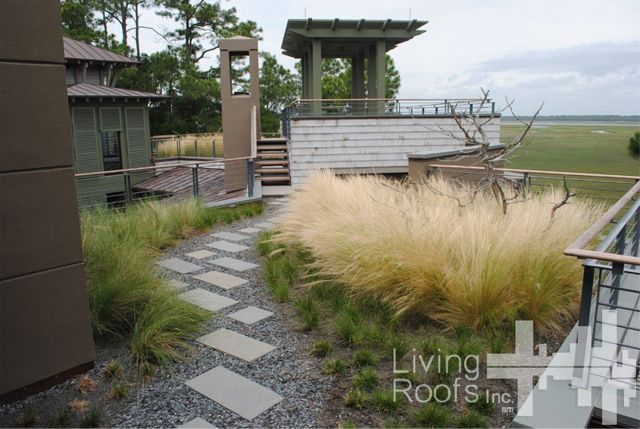
Built-in-place custom Private Kiawah Island, SC Residence green roof by Living Roofs, Inc., a design/build company.
It takes a village to make a good green roof — at least an engineer, an architectural designer, landscape architect, designer or horticulturalist; product support and, of course, a competent roofing contractor. Manufacturers and proponents who wish to promote and support green roof options are urged to reach out to the growing market of small residential contractors through the communities that they establish online and in their local markets.

Home improvement expert Michael Chotiner writes about tools and home projects for Home Depot. Using his experience as a general contractor, Michael provides tips and insights on the use of materials and power tools for roofing and other projects. To view many of the power tools available at Home Depot, you can visit the website’s power tool section.
Comments or questions for Michael may be sent to Laura Nehse of Home Depot at: LAURA_A_NEHSE@homedepot.com.
 Greenroofs.comConnecting the Planet + Living Architecture
Greenroofs.comConnecting the Planet + Living Architecture





Exactly how To End Up With The Right Roofer Not The Incorrect One – The Love of Noer 876
[…] make certain that you examine the advantages of all contractors who want to work with your project. https://www.greenroofs.com/2014/08/15/what-remodeling-contractors-worry-about-when-asked-to-bid-a-gr… ought to be totally confident that who you work with will have the ability to remain on budget as […]
How To End Up With The Right Professional Roofer Not The Incorrect One – The Love of Smith 133
[…] a great service provider, the result of the project is additionally favorably affected. Read on for https://www.greenroofs.com/2014/08/15/what-remodeling-contractors-worry-about-when-asked-to-bid-a-gr… on locating the ideal professional for your work.While doing negotiations with a possible roofing […]
Valuable Tips On Just How To Discover The Perfect Roofer For The Task – The Journaling of Frandsen 804
[…] inUncategorized Authored by- https://www.greenroofs.com/2014/08/15/what-remodeling-contractors-worry-about-when-asked-to-bid-a-gr… ‘s of fantastic value when you do a thorough research study before working with a roof […]
Basic Actions To Follow When Searching For The Best Roofing Contractor For You – The Love of Bruce 030
[…] at one factor use money as type of repayment.<img src='https://slipperysloperoofing.ca/wp- Highly recommended Website /uploads/2019/04/Ticket-94681-Slippery-Slope-Roofing_Approved.jpg’ width=’533′ […]
Exactly how To Find The Very Best Professional Roofer As Opposed To The Worst – The Love of Krause 684
[…] take on the job, supply in a timely manner as well as beyond expectation. Naturally, making https://www.greenroofs.com/2014/08/15/what-remodeling-contractors-worry-about-when-asked-to-bid-a-gr… is offered enough time to do the job well is likewise essential. Find out exactly how the provider […]
Practical Tips On Exactly How To Find The Perfect Roofer For The Job – The Life of Vest 726
[…] you as well as your provider set is clearly mentioned in the legal arrangement. There’s https://www.greenroofs.com/2014/08/15/what-remodeling-contractors-worry-about-when-asked-to-bid-a-gr… for you to authorize anything before you get to an arrangement with the contractor concerning the […]
Locate A Great Roofing Contractor With No Effort – The Blogging of Stokholm 167
[…] arrangements, develop a timeline for the project, with affordable milestones you both set. https://www.greenroofs.com/2014/08/15/what-remodeling-contractors-worry-about-when-asked-to-bid-a-gr… of the lawful contract should certainly be saved in a created record which both events need to […]
Best Roofing Contractors Are Nearby If You Follow These – The Love of Mouridsen 187
[…] fine with the job done by checking it yourself or work with another person do the inspection. Make try this web-site is done successfully and also do not make the last repayment up until you feel completely […]
The Right Process To Finding A Good Roofer – The Blogging of Mejer 186
[…] to working with a sought-after contractor and that is they may not prepare to focus just on you. At linked website of the day, count on your gut in your hiring decisions.Seeking […]
How To Wind up With The Right Professional Roofer Not The Wrong One – The Life of Zhao 371
[…] to demand updates from your professional to guarantee that they are remaining on timetable. If Affordable Roofing 33179 isn’t brand-new in the business, he ought to provide you with an aesthetic slide show of the […]
Timeless Tricks On How You Can Locate Roofer – The Journey of Ismail 841
[…] also utilize items that are of a high-grade, otherwise the entire job could be endangered. Learn Roof Financing 33025 of any unique material that could be needed consisting of care and maintenance after mounting.Every […]
A Proven Way To Find Great Roofer That Deserve The Cash! – The Life of Womble 258
[…] of speaking with the specialist, ask him these rules and also see if he is conversant with them. mouse click the up coming post ought to be current with any and all rules and also regulations. Propose a couple of created […]
To Find The Right Roofer You Should Follow These Actions! – The Love of Dodd 776
[…] look appealing so you can research their roof repair service company or established an interview. https://www.greenroofs.com/2014/08/15/what-remodeling-contractors-worry-about-when-asked-to-bid-a-gr… need to constantly consist of the full financial information, consisting of repayment schedules, in […]
Employing The Best Qualified Roofing Contractor In Your Area Is Not A Secret – The Journey of Nelson 484
[…] talk to have just good things to claim, proceed and work with the specialist. There are likewise https://www.greenroofs.com/2014/08/15/what-remodeling-contractors-worry-about-when-asked-to-bid-a-gr… , when you have a few other issues.If you have actually solicited multiple quotes from potential […]
The Proper Way To Discover The Right Roofing Contractor – Getting Thermal Energy From The Sun To Work For You
[…] so it is necessary to employ somebody with a record that confirms that. To effectively guarantee https://www.greenroofs.com/2014/08/15/what-remodeling-contractors-worry-about-when-asked-to-bid-a-gr… is proceeding well, request your service provider to provide you daily updates. You specialist […]
Tips To Comply With To Discover The Best Professional Roofer – Getting Thermal Energy From The Sun To Work For You
[…] get the solution to all your inquiries prior to hiring a service provider for your task.To make https://www.greenroofs.com/2014/08/15/what-remodeling-contractors-worry-about-when-asked-to-bid-a-gr… goes smoothly with your company and also your family pet animal, you ought to allow the service […]
Tips On How To Limit Your Alternatives When Finding A Great Professional Roofer – The Blogging of Cain 686
[…] repair service service provider for a job. When determining which bid to approve, do not make Best Roofing Company 33407 of just accepting the most affordable proposal. You will usually receive much better high quality […]
Discover Just How To Find Yourself Working With The Very Best Professional Roofer – The Love of Petty 636
[…] they guarantee. Getting the best contractor has a fantastic effect on the end result of your job. https://www.greenroofs.com/2014/08/15/what-remodeling-contractors-worry-about-when-asked-to-bid-a-gr… to are useful tips to help you obtain the best professional for your project.To make the most […]
Exactly how To Wind up With The Right Roofer Not The Incorrect One – The Journaling of Burch 120
[…] is current on the regulations and guidelines, it is simpler to complete a work quickly. Give mouse click the next site by recommending a couple of cooked up situations and also ask him how he would react to […]
Keys To Searching For The Right Professional Roofer For Your Project Demands – The Journaling of Sutton 855
[…] really used their services so that you might make an enlightened decision regarding employing them. informative post are an excellent sign of the contractor’s honesty; guarantee you get a couple of them. Ensure […]
Professional roofer – A Couple Of Tips For Residential Roof Covering With Different Techniques And Also Products – The Love of Cheng 612
[…] sorts of jobs, whether it’s fixing damaged roofing systems or mounting new roofs. In https://www.greenroofs.com/2014/08/15/what-remodeling-contractors-worry-about-when-asked-to-bid-a-gr… , because they are typically rather seasoned at what they do, they’ll know the most effective […]
Easy Tips That Will Certainly Help You Take Care Of Your Roofing – The Blogging of Straarup 611
[…] bundles for the inevitable repairs you will need.Ask your friends for advice regarding your roof. Roof Repair 75051 maintain their homes by themselves, and are happy to help a friend to learn how to do the same. […]
Roof Recommendations Every Person Requirements To Find Out About – The Journaling of Kendall 660
[…] You can obtain referrals from family, friends, or other businesses you may be involved with. read this post here can check the phone book or Yellow Pages to see who is listed locally. You can also check for local […]